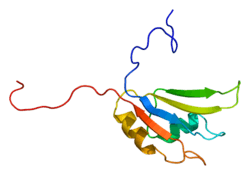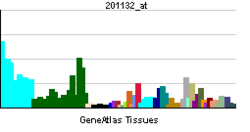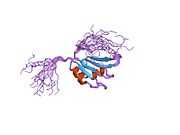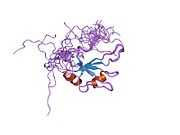HNRPH2
| Heterogeneous nuclear ribonucleoprotein H2 (H') | |||||||||||||
|---|---|---|---|---|---|---|---|---|---|---|---|---|---|
 PDB rendering based on 1wez. | |||||||||||||
| |||||||||||||
| Identifiers | |||||||||||||
| Symbols | HNRNPH2 ; FTP3; HNRPH'; HNRPH2; hnRNPH' | ||||||||||||
| External IDs | OMIM: 300610 MGI: 1201779 HomoloGene: 23165 GeneCards: HNRNPH2 Gene | ||||||||||||
| |||||||||||||
| RNA expression pattern | |||||||||||||
 | |||||||||||||
| More reference expression data | |||||||||||||
| Orthologs | |||||||||||||
| Species | Human | Mouse | |||||||||||
| Entrez | 3188 | 56258 | |||||||||||
| Ensembl | ENSG00000126945 | ENSMUSG00000045427 | |||||||||||
| UniProt | P55795 | P70333 | |||||||||||
| RefSeq (mRNA) | NM_001032393 | NM_019868 | |||||||||||
| RefSeq (protein) | NP_001027565 | NP_063921 | |||||||||||
| Location (UCSC) | Chr HG1439_PATCH: 100.66 – 100.67 Mb | Chr X: 134.6 – 134.61 Mb | |||||||||||
| PubMed search | |||||||||||||
Heterogeneous nuclear ribonucleoprotein H2 is a protein that in humans is encoded by the HNRNPH2 gene.[1][2]
This gene belongs to the subfamily of ubiquitously expressed heterogeneous nuclear ribonucleoproteins (hnRNPs). The hnRNPs are RNA binding proteins and they complex with heterogeneous nuclear RNA (hnRNA). These proteins are associated with pre-mRNAs in the nucleus and appear to influence pre-mRNA processing and other aspects of mRNA metabolism and transport. While all of the hnRNPs are present in the nucleus some seem to shuttle between the nucleus and the cytoplasm. The hnRNP proteins have distinct nucleic acid binding properties. The protein encoded by this gene has three repeats of quasi-RRM domains that binds to RNAs. It is very similar to the family member HNRPH1. This gene is thought to be involved in Fabry disease and X-linked agammaglobulinemia phenotype. Alternative splicing results in multiple transcript variants encoding the same protein.[2]
References
- ↑ Honore B, Rasmussen HH, Vorum H, Dejgaard K, Liu X, Gromov P, Madsen P, Gesser B, Tommerup N, Celis JE (Jan 1996). "Heterogeneous nuclear ribonucleoproteins H, H', and F are members of a ubiquitously expressed subfamily of related but distinct proteins encoded by genes mapping to different chromosomes". J Biol Chem 270 (48): 28780–9. doi:10.1074/jbc.270.48.28780. PMID 7499401.
- ↑ 2.0 2.1 "Entrez Gene: HNRPH2 heterogeneous nuclear ribonucleoprotein H2 (H')".
Further reading
- Vorechovský I, Vetrie D, Holland J et al. (1994). "Isolation of cosmid and cDNA clones in the region surrounding the BTK gene at Xq21.3-q22.". Genomics 21 (3): 517–24. doi:10.1006/geno.1994.1310. PMID 7959728.
- Vetrie D, Vorechovský I, Sideras P et al. (1993). "The gene involved in X-linked agammaglobulinaemia is a member of the src family of protein-tyrosine kinases.". Nature 361 (6409): 226–33. doi:10.1038/361226a0. PMID 8380905.
- Tsukada S, Saffran DC, Rawlings DJ et al. (1993). "Deficient expression of a B cell cytoplasmic tyrosine kinase in human X-linked agammaglobulinemia.". Cell 72 (2): 279–90. doi:10.1016/0092-8674(93)90667-F. PMID 8425221.
- Oeltjen JC, Malley TM, Muzny DM et al. (1997). "Large-scale comparative sequence analysis of the human and murine Bruton's tyrosine kinase loci reveals conserved regulatory domains.". Genome Res. 7 (4): 315–29. doi:10.1101/gr.7.4.315. PMID 9110171.
- Honoré B, Vorum H, Baandrup U (1999). "hnRNPs H, H' and F behave differently with respect to posttranslational cleavage and subcellular localization.". FEBS Lett. 456 (2): 274–80. doi:10.1016/S0014-5793(99)00911-4. PMID 10456323.
- Zhang Y, Lindblom T, Chang A et al. (2001). "Evidence that dim1 associates with proteins involved in pre-mRNA splicing, and delineation of residues essential for dim1 interactions with hnRNP F and Npw38/PQBP-1.". Gene 257 (1): 33–43. doi:10.1016/S0378-1119(00)00372-3. PMID 11054566.
- Caputi M, Zahler AM (2001). "Determination of the RNA binding specificity of the heterogeneous nuclear ribonucleoprotein (hnRNP) H/H'/F/2H9 family.". J. Biol. Chem. 276 (47): 43850–9. doi:10.1074/jbc.M102861200. PMID 11571276.
- Shu H, Chen S, Bi Q et al. (2004). "Identification of phosphoproteins and their phosphorylation sites in the WEHI-231 B lymphoma cell line.". Mol. Cell Proteomics 3 (3): 279–86. doi:10.1074/mcp.D300003-MCP200. PMID 14729942.
- Bouwmeester T, Bauch A, Ruffner H et al. (2004). "A physical and functional map of the human TNF-alpha/NF-kappa B signal transduction pathway.". Nat. Cell Biol. 6 (2): 97–105. doi:10.1038/ncb1086. PMID 14743216.
- Honoré B, Baandrup U, Vorum H (2004). "Heterogeneous nuclear ribonucleoproteins F and H/H' show differential expression in normal and selected cancer tissues.". Exp. Cell Res. 294 (1): 199–209. doi:10.1016/j.yexcr.2003.11.011. PMID 14980514.
- Ross MT, Grafham DV, Coffey AJ et al. (2005). "The DNA sequence of the human X chromosome.". Nature 434 (7031): 325–37. doi:10.1038/nature03440. PMC 2665286. PMID 15772651.
- Alkan SA, Martincic K, Milcarek C (2006). "The hnRNPs F and H2 bind to similar sequences to influence gene expression.". Biochem. J. 393 (Pt 1): 361–71. doi:10.1042/BJ20050538. PMC 1383695. PMID 16171461.
- Olsen JV, Blagoev B, Gnad F et al. (2006). "Global, in vivo, and site-specific phosphorylation dynamics in signaling networks.". Cell 127 (3): 635–48. doi:10.1016/j.cell.2006.09.026. PMID 17081983.
| |||||||||||

